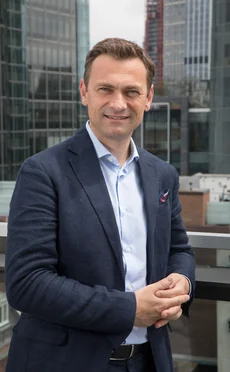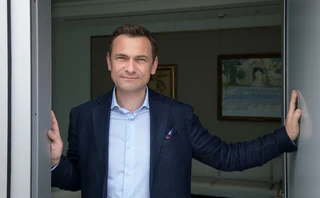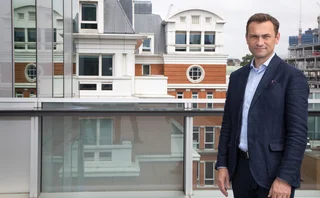Tug of War: ING's Legrand Digs Into the Bank's Innovation Program
With Benoît Legrand firmly in the driver’s seat, the last four years have seen ING push to transform its IT landscape and approach to innovation.

Behind closed doors and within the four walls of a bank, there is a constant tug of war. It’s a battle of resources between what is crucial to business operations and regulatory requirements, and what can propel the institution into the future.
In most cases, it is a losing fight for innovation. But when Ralph Hamers, CEO of ING, approached Benoît Legrand in 2015, he asked for his help with transforming the bank’s technology infrastructure and modernizing its approach to fintech.
“Four years ago, the word ‘fintech’ didn’t exist or was just beginning to emerge, and it was then that Ralph Hamers asked me, ‘Are we fast enough?’” Legrand recalls. “And if you looked around, you would have seen that we were much slower than the rest of the world. We needed to accelerate.”
Part of the reason he was asked to take on the challenge, ironically, was his ability to manage fintech failures. Having worked with ING for close to 20 years at this point, and as acting president of ING France, he remembers having just come away from a “bad experience” with a fintech partnership as a result of multiple operational failures.
“It was based on that idea of failure,” explains Legrand. He recalls that Hamers said, “‘You might be the right guy because you know what it takes to run a business; you know investment banking and direct banking; you can connect with people and if we effectively want to drive change, I think it is important to bring all of those elements together.’”

But driving innovation agendas carries many challenges, as Legrand has learned. Some of the major roadblocks are common among financial institutions, such as shifting the cultural mindset and unraveling decades-old legacy technologies that are bolted onto a myriad of systems. He explains that a lot of the apprehension derives from being afraid of failure—the fear of not delivering solutions to problems with each project that is pushed, or being unable to manage the pressure banks face to ensure 100% system availability.
“Those are the fears that people have at the beginning and this is still one of the biggest challenges: to reassure people that they can take those steps and make enough space in their agenda and budgets to discover new technologies for the future,” Legrand says.
Still, the bank has an aggressive innovation program that incorporates many buzzwords, but it also moves beyond that into creating truly transformational solutions.
Moving Mountains
Four years ago, Legrand’s mission was to navigate and develop ING’s innovation strategy. With the new mandate in place, he started as head of fintech in October 2015 and dedicated the next three months to putting together a small team of three people to help evaluate the organization’s pain points. Over the coming months, they aimed to grow the innovation agenda by partnering with new fintech firms, changing the mindset around exploring new technologies and gradually building out the team.
“It was done step by step,” he says. “It was very much like the Chinese philosophy where a man who wants to move a mountain should start by removing small stones.”
Today, as chief innovation officer and CEO of ING Ventures—a role he took on in 2018—Legrand manages multi-million-dollar budgets and various teams responsible for innovation governance and incorporation, scouting fintechs, signing partnerships, overseeing wholesale banking innovation, and running labs across Amsterdam, Singapore, and London. Within that, he manages the bank’s methodology team called PACE, which combines three primary approaches: agile development, lean start-up, design-thinking, combined with a focus on the user experience.
Across the bank, he has helped scout about 1,800 fintechs, signed 160 different fintech partnerships, invested over €200 million ($225 million) in 25 venture capital investments, and rolled out 50 start-up initiatives in labs across the globe. According to Legrand, a large part of the job is also ensuring start-ups and new technologies are properly nurtured throughout the different stages of the innovation labs.

“Those companies that are still scaling need to be protected from the rest of the organization,” he says. “I need to shield them and make sure that until they are mature enough, they are not affected or slowed down by the rest of the organization.”
On the flip side, banks are also required to carry out the necessary due diligence before committing to these risky firms, as 90% of start-ups fail. As such, since 2015, Legrand has had to make some tough decisions. Over those four years, ING dropped about 70 partnerships with fintech companies. As Legrand explains, there were many reasons why the bank put an end to working with certain vendors, with the most common cases involving failure to deliver on expectations, inability to meet cybersecurity or compliance requirements, a change in the bank’s priorities, and, in some cases, ING was simply unable to keep up with the start-up’s pace of development.
“It is also important to know when to stop [partnerships], as well,” he adds. “It is easier to start them, but more difficult to stop.”
Data Governance
Like any head of innovation, Legrand’s eyes remain on the road ahead, constantly looking at ways to develop new strengths. Yet one such resource that has yet to be fully leveraged is the mountain of data that has been running through banks’ systems since the digital awakening in the 1990s. For ING, this is no different.
“Although digitization is not new, we have still not used that data in an effective way,” Legrand says. “We have not organized it in an effective way and there is a lot of work that now needs to be done to make it usable or interoperable.”
Legrand explains that a long-term aim for the bank is to be able to effectively manage the bank’s internal and external data sources to improve efficiency and better service its retail customers and professional client base. This involves improving interoperability throughout the organization’s systems and creating valuable data assets for historic and real-time data analysis. For now, at least, it’s a matter of exploring the different technologies that will help the bank to achieve this centralized data asset. Legrand points to the potential of new technology, such as artificial intelligence (AI), blockchain and other forms of distributed-ledger technology (DLT) to help solve these problems. “Whatever technology helps us to get there,” he says.

Like many sell-side firms, including Deutsche Bank and Bank of America, ING is also gradually migrating much of its infrastructure to the cloud. It’s a big step for any heavily regulated financial institution. In this case, however, the bank has opted to use a private cloud model, similar to Bank of America. As most fintechs are now cloud-native, moving ING’s functions to a virtual environment has allowed for simpler integrations and an array of other operational and data benefits.
“It allows flexibility and variability of the cost, which are very important, and [supports] the availability and accessibility of data—things that are of immense value in a world where things move very fast,” Legrand says.
But leveraging data as an asset comes with a warning label, particularly in cases where institutions seek to use banking data relating to credit card details, customer location, online activity or personally identifiable information (PII). This type of data can produce valuable insights into company performance, investment opportunities, and client behavior. Yet, as Legrand explains, firms like ING are having to tread very carefully in how they process the data to avoid breaching global data protection laws, such as the General Data Protection Regulation (GDPR), which came into effect in May 2018.
“This is the risk we have with data,” he says. “But it is not about having the data, as having data is OK, but it’s what you do with it.”
The Enablers & Disruptors
In the financial markets, the term “disruptive technology” is often followed by examples such as AI, blockchain or cloud computing. Legrand says the bank is developing its own type of disruptive technology, known as software-building-software, or an automated coding environment.
ING is currently piloting the technology in a bid to build one of its wholesale front-office systems to replace an old, legacy platform, and will be tested over the next 12 months. The software is being developed in ING’s Amsterdam labs and aims to transform the bank’s IT development landscape in that users can simply request the functionality required for a product, which is then auto-generated within the coding environment.
“Our vision is to disrupt IT development. There is some work to be done and it is going to take years to get there, but we believe there is an immense need in the world to disrupt those areas,” Legrand says.

If successful, the automated coding environment will set the template for developing other platforms and tools. It is expected that this software will be product-agnostic, meaning that it could be programmed to build any technology. It aims to be able to develop products in a fraction of the time that it takes for a developer, and remove any potential disagreements between IT teams during development.
ING has multiple projects and initiatives in development across the globe, but bond trading is one area to which the bank has been dedicating its energy. Legrand explains that the firm is using AI to produce predictive analytics on the price of bonds. The technology will incorporate machine learning to detect patterns and insights from historical data and pricing information to enable traders to make more informed investment decisions.
“Of course, it is not black or white science, but it gives you a price range and it helps the traders to be more effective in making decisions,” Legrand says. “This is an example of what I would call the bionic bank, where you still need the trader to say, ‘What do I want?’ But the individual is helped an awful lot by the technology to make faster and better decisions.”
The Paradigm Shift
Although there is still a long way to go, Legrand is gradually seeing the fruits of his efforts in changing the bank’s approach to new technology, partnerships, and innovation. Competing with the heavyweight banks of the world is a daunting endeavor, but one that needs to be undertaken to guarantee the bank’s place in the future. As Legrand recalls, when Hamers evaluated the bank over five years ago, he knew it was important to start planning for the long term to ensure the bank would still be there in 10 years and could show that it had transformed in that period.
As part of the process, Legrand explains that it’s important to strike that balance and gradually work toward a long-term goal, “I think [it’s important to document] the results quarterly and yearly and show that we are effectively transforming and managing our costs,” he adds. “But also keep enough space in your mind for time and budget, because naturally, those things can fade.”
But making that change cannot be achieved alone and attracting the right talent is crucial. Since these changes, where there is a greater focus on innovation and agile working, Legrand says that recruiting the right people has become less of a challenge. In most cases, new talent is more easily attracted to fintechs, working in labs, modern IT environments, projects that obtain fast results, and workplaces with less hierarchical management.
“Those guys are not there to make a career for 45 years. They want to learn, they want to solve a problem, so either that means [they are] in the company to get those things, or they move on,” says Legrand.
People will continue to play a major role in shaping and transforming the bank for years to come. As technology advances, Legrand will ensure that there is always a human involved in making the final decision, monitoring its activity and ensuring the technology is effective in resolving the bank’s problems.
“There is always a valuable human being that needs to understand why it is teaching the machine do these kinds of things,” Legrand says, adding that firms need to understand the problem quickly that is being solved for and if it is this an effective solution? “That is why we see technology as an enabler to transforming the banking industry.”

Further reading
Only users who have a paid subscription or are part of a corporate subscription are able to print or copy content.
To access these options, along with all other subscription benefits, please contact info@waterstechnology.com or view our subscription options here: http://subscriptions.waterstechnology.com/subscribe
You are currently unable to print this content. Please contact info@waterstechnology.com to find out more.
You are currently unable to copy this content. Please contact info@waterstechnology.com to find out more.
Copyright Infopro Digital Limited. All rights reserved.
As outlined in our terms and conditions, https://www.infopro-digital.com/terms-and-conditions/subscriptions/ (point 2.4), printing is limited to a single copy.
If you would like to purchase additional rights please email info@waterstechnology.com
Copyright Infopro Digital Limited. All rights reserved.
You may share this content using our article tools. As outlined in our terms and conditions, https://www.infopro-digital.com/terms-and-conditions/subscriptions/ (clause 2.4), an Authorised User may only make one copy of the materials for their own personal use. You must also comply with the restrictions in clause 2.5.
If you would like to purchase additional rights please email info@waterstechnology.com
More on Data Management
New working group to create open framework for managing rising market data costs
Substantive Research is putting together a working group of market data-consuming firms with the aim of crafting quantitative metrics for market data cost avoidance.
Off-channel messaging (and regulators) still a massive headache for banks
Waters Wrap: Anthony wonders why US regulators are waging a war using fines, while European regulators have chosen a less draconian path.
Back to basics: Data management woes continue for the buy side
Data management platform Fencore helps investment managers resolve symptoms of not having a central data layer.
‘Feature, not a bug’: Bloomberg makes the case for Figi
Bloomberg created the Figi identifier, but ceded all its rights to the Object Management Group 10 years ago. Here, Bloomberg’s Richard Robinson and Steve Meizanis write to dispel what they believe to be misconceptions about Figi and the FDTA.
SS&C builds data mesh to unite acquired platforms
The vendor is using GenAI and APIs as part of the ongoing project.
Aussie asset managers struggle to meet ‘bank-like’ collateral, margin obligations
New margin and collateral requirements imposed by UMR and its regulator, Apra, are forcing buy-side firms to find tools to help.
Where have all the exchange platform providers gone?
The IMD Wrap: Running an exchange is a profitable business. The margins on market data sales alone can be staggering. And since every exchange needs a reliable and efficient exchange technology stack, Max asks why more vendors aren’t diving into this space.
Reading the bones: Citi, BNY, Morgan Stanley invest in AI, alt data, & private markets
Investment arms at large US banks are taken with emerging technologies such as generative AI, alternative and unstructured data, and private markets as they look to partner with, acquire, and invest in leading startups.







